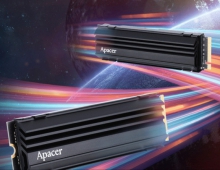Apacer Steno AB320 MP3 Player Review
4. Perfromance tests
Review Pages
In order to test the reading/writing performance of the Apacer Steno, we used two well known benchmarking applications, HD Tach and Sisoft Sandra 2005 SR1. All tests were conducted under the WinXP x64 environment with an ASUS P5GD2 Premium motherboard (USB2.0 compatible).
HD Tach Results


Sisoft Sandra 2005 SR2 Results
Sisoft Sandra has two series of tests.
- The "File system" which tests how your drive(s) and controller(s) compare to other devices in a typical system:
· Read Test: Buffered, Random, Sequential
· Write Test: Buffered, Random, Sequential
· Seek Test
The "Drive Index" mark is a composite figure representing an overall performance rating based on the average of the read, write, and seek tests, and file and cache size. The Drive Index is intended to represent drive performance under typical use in a PC. A larger number means better performance. The weighting of the results is not equal, it represents the distribution of different files sizes as used on these devices (obtained through field research).

The AB320 showed a rather slow performance with "only" 3033 Kb/s, while other flash drives can do up to 8MB/s..
- The "Compact Flash", the typical usage model for these devices is File operations, such as Writing a file to the device, reading a file from it, and deleting a file, this benchmark exercises the devices in terms of these operations (to measure the “raw” cluster level performance of the device, it is recommended to also test it by means of the File System Benchmark module). The following characteristics are measured for each of the four representative files sizes of 512 Bytes (representing a minimal single data cluster file), 32kB, 256kB and 2MB. The weighting of the results is not equal, it represents the distribution of different files sizes as used on these devices (obtained through field research). For each of the four file sizes a Combined Index is then calculated, stating the combined performance in terms of Combined Operations Per Second, with respect to a mix of write, read and delete operations.
- Combined Device Index: is a composite figure representing an overall performance rating based on the average of the Combined Index figures over the four file sizes. (Higher is better, i.e. better performance)
- Endurance Factor: is a figure representing the Wear and Life Expectancy of flash devices; this is obtained by dividing the average performance (normal condition, i.e. sequential write) to the lowest performance (high-stress condition, i.e. same block re-write). It measures the relative improvement of endurance caused by the wear leveling or flash management algorithm; the absolute endurance of a device (i.e. its expected life-time) is directly dependent, in addition to this Endurance Factor, on the nominal manufacturer rating of maximum erase/reprogram cycles, which is typically 100,000+ for SLC and 10,000+ for MLC devices. (Higher is better, i.e. longer life-time for the device)


The Combined Index factor is rather low, with only 982 operation/min, while the endurance factor the highest compared with the other flash devices.
Review Pages





















